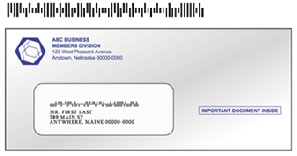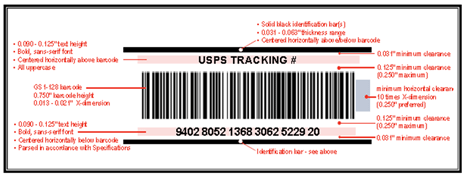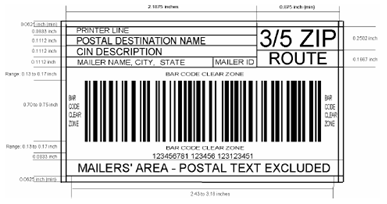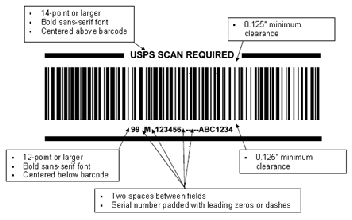


Copyright © 2016 South Jersey PCC - All Rights Reserved
Powered by P & T Computing
Your open communication
To the US Postal Service





Intelligent Mail® Full-Service:
What's In the Barcodes?
Intelligent Mail® Full-Service - it seems to be all anyone is talking about these days. The January 26, 2014 deadline for implementing Full-Service to be eligible for automation discounts on your mail is right around the corner. At the heart of Full-Service Intelligent Mail are several very important, and required, barcodes. So, what exactly are all the required barcodes, and what data is in those barcodes?
IM Piece Barcode
The first requirement for Full-Service is to place a unique barcode on the individual mailpieces. Due to the various types of processing equipment used by the USPS to sort different types of mail, the barcode for Letter and Flat-sized mail (IMb) is different than the barcode for parcel size mail (IMPB).
Mailpiece Barcode for Letters and Flats

The Intelligent Mail barcode for Letters and Flats consists of 65 bars, which represent 31 characters of data. The data consists of a 20-character "Tracking Code" and an 11-character "Routing Code." The Tracking Code is further broken down into these 4 components:
- Barcode ID: a 2-character identification code that essentially represents the level of presort for the mailpiece.
- Service Type ID (STID): a 3-character identification code that represents the class of mail, Intelligent Mail option (Full-Service or Basic) and any services requested, such as Address Correction Service (ACS).
- Mailer ID (MID): a 6-character or 9-character identification code that identifies the mail owner, the mail preparer, or a mailing agent. These codes are assigned by the USPS and are based on annual mail volumes.
- Serial Number: a 6-character or 9-character (depending on the length of the MID) identification code that identifies the mailpiece itself.
The Routing Code is the ZIP Code of the addressee on the mailpiece. It may consist of just the 5-digit ZIP code or it may also include the ZIP + 4 code and Delivery Point code.
Full-Service requires that mailpieces have unique barcodes, and this uniqueness must be maintained for a period of at least 45 days from the date of mailing as presented on the postage statement. The combination of the STID, Mailer ID and Serial Number (shown below) are used to determine the uniqueness.

I
Intelligent Mail Package Barcode

USPS tracking information for mailers.Source: USPS2000508 - Barcode Package Intelligent Mail Specification
2011-12-29 Rev E.doc
The Intelligent Mail Package Barcode (IMpb) can vary in length, and may consist of 20, 26, 30 or 34 characters of data. Like the barcode for Letters and Flats, the Package barcode consists of Routing Information and Tracking Information. The Routing Information is further broken down into these 2 components:
- Postal Routing Code Application Identifier: a 3-character identification code that must be used if the Destination ZIP code is included. When used, it is always "420."
- Destination ZIP Code: a 5-digit or 9-digit ZIP code of the addressee
The Tracking Information is broken down into these 5 components:
- Channel Application Identifier: a 2-character code that is always "92" when a 9-digit Mailer ID is used and is always "93" when a 6-digit Mailer ID is used.
- Service Type ID (STID): a 3-character identification code that represents the class of mail and product/service combination.
- Mailer ID: a 6-character or 9-character identification code that identifies the mail owner, the mail preparer, or a mailing agent. These codes are assigned by the USPS and are based on annual mail volumes.
- Serial Number: a 7-, 10-, 11-, or 14-digit identification code that identifies the mailpiece itself. If the Mailer ID is 9-digits, the serial number should be a 7- or 11-digit number and if the Mailer ID is 6-digits, a 10- or 14-digit number should be used.
- Mod 10 Check Digit: a 1-digit check digit that is programmatically calculated.
For Packages, the barcodes must remain unique for a period of 180 days from the date of mailing.
Intelligent Mail Container Barcode
Full-Service also requires that the labels for handling units (trays, sacks) and containers (pallets, Gaylords, APC's, OTR's, etc.) also contain a unique barcode.
Tray Barcodes
(for handling units, such as mail sacks or mail trays)
The tray barcodes consist of a 24-digit data string with the following 6 components:
Destination ZIP Code: the 5-digit ZIP code of the destination of the handling unit
- Content ID Number: a 3-digit code representing the presort qualification of the handling unit
- Processing Code: a 1-digit code that indicates if the mail is automation, machineable, etc.
- Mailer ID: a 6-character or 9-character identification code that identifies the mail owner, the mail preparer, or a mailing agent. These codes are assigned by the USPS and are based on annual mail volumes.
- Serial Number: a 9 or 12-character identification code (based on the length of the MID) that identifies the handling unit itself.
- Label Type: a 1-digit code that indicates the length of the Mailer ID
Container Barcodes
(for containers such as pallets, Gaylords, APC's, OTR's)
The container barcodes consist of a 21-digit data string with the following 4 components:
- Application ID: a 2-digit code, always "99."
- Type Indicator: a 1-digit code, always "M."
- Mailer ID: a 6-character or 9-character identification code that identifies the mail owner, the mail preparer, or a mailing agent.
- These codes are assigned by the USPS and are based on annual mail volumes.
- Serial Number: a 9 or 12-character identification code (based on the length of the MID) that identifies the container itself.
Like the Intelligent Mail piece barcodes, these handling unit an container barcodes must maintain their uniqueness for a period of at least 45 days from the date of mailing.
A USPS scan is required.
Source: Barcode, Container, Intelligent Mail, USPS-B-3215
Mailer ID
So, how do you determine which Mailer ID to use in all of these barcodes? The answer is - it depends. Keep in mind that any entity in the mailing supply chain may have multiple Mailer ID's, and that the Mailer ID is a key component of managing the uniqueness of the barcodes. For this reason, it is important to use careful planning when determining which Mailer ID to use in the barcodes. You also need to keep in mind who you want to receive the data for any services that you are requesting for the mailing. For example, if you are using Address Correction Services, the Mailer ID on the mailpiece barcode needs to be that of the entity that will receive the ACS data from the USPS. Likewise, if you are using IMb Tracing, the Mailer ID on the mailpiece barcode needs to be that of the entity that you want to receive the tracking data. For the handling unit and container barcodes, you may elect to use the Mailer ID of the mail owner or the mail preparer.
Managing Uniqueness
What about managing the uniqueness? There are many different strategies for managing the uniqueness of the barcodes. Some mailers use different Mailer IDs for different classes of mail, or for different mail service providers. Others use a single Mailer ID and then manage the uniqueness using defined ranges of serial numbers for different projects or mail service providers. Regardless of the strategy, it will require a complex database to manage these barcodes. There are many presort software providers who offer means to manage the barcode uniqueness, as well as many third-party service providers, so you don't need to try to manage this on your own. Post-presort software solutions, such as Window Book's DAT-MAIL, can help you manage the uniqueness for handling tray and container barcodes.